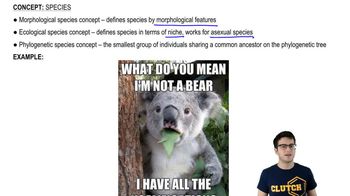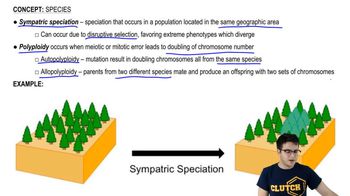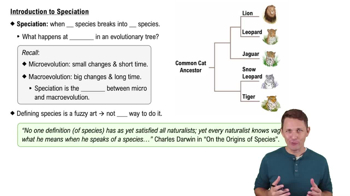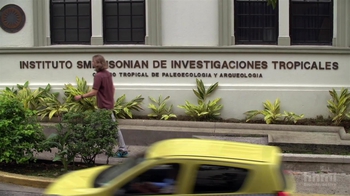Table of contents
- 1. Introduction to Biology2h 42m
- 2. Chemistry3h 40m
- 3. Water1h 26m
- 4. Biomolecules2h 23m
- 5. Cell Components2h 26m
- 6. The Membrane2h 31m
- 7. Energy and Metabolism2h 0m
- 8. Respiration2h 40m
- 9. Photosynthesis2h 49m
- 10. Cell Signaling59m
- 11. Cell Division2h 47m
- 12. Meiosis2h 0m
- 13. Mendelian Genetics4h 44m
- Introduction to Mendel's Experiments7m
- Genotype vs. Phenotype17m
- Punnett Squares13m
- Mendel's Experiments26m
- Mendel's Laws18m
- Monohybrid Crosses19m
- Test Crosses14m
- Dihybrid Crosses20m
- Punnett Square Probability26m
- Incomplete Dominance vs. Codominance20m
- Epistasis7m
- Non-Mendelian Genetics12m
- Pedigrees6m
- Autosomal Inheritance21m
- Sex-Linked Inheritance43m
- X-Inactivation9m
- 14. DNA Synthesis2h 27m
- 15. Gene Expression3h 20m
- 16. Regulation of Expression3h 31m
- Introduction to Regulation of Gene Expression13m
- Prokaryotic Gene Regulation via Operons27m
- The Lac Operon21m
- Glucose's Impact on Lac Operon25m
- The Trp Operon20m
- Review of the Lac Operon & Trp Operon11m
- Introduction to Eukaryotic Gene Regulation9m
- Eukaryotic Chromatin Modifications16m
- Eukaryotic Transcriptional Control22m
- Eukaryotic Post-Transcriptional Regulation28m
- Eukaryotic Post-Translational Regulation13m
- 17. Viruses37m
- 18. Biotechnology2h 58m
- 19. Genomics17m
- 20. Development1h 5m
- 21. Evolution3h 1m
- 22. Evolution of Populations3h 52m
- 23. Speciation1h 37m
- 24. History of Life on Earth2h 6m
- 25. Phylogeny2h 31m
- 26. Prokaryotes4h 59m
- 27. Protists1h 12m
- 28. Plants1h 22m
- 29. Fungi36m
- 30. Overview of Animals34m
- 31. Invertebrates1h 2m
- 32. Vertebrates50m
- 33. Plant Anatomy1h 3m
- 34. Vascular Plant Transport1h 2m
- 35. Soil37m
- 36. Plant Reproduction47m
- 37. Plant Sensation and Response1h 9m
- 38. Animal Form and Function1h 19m
- 39. Digestive System1h 10m
- 40. Circulatory System1h 57m
- 41. Immune System1h 12m
- 42. Osmoregulation and Excretion50m
- 43. Endocrine System1h 4m
- 44. Animal Reproduction1h 2m
- 45. Nervous System1h 55m
- 46. Sensory Systems46m
- 47. Muscle Systems23m
- 48. Ecology3h 11m
- Introduction to Ecology20m
- Biogeography14m
- Earth's Climate Patterns50m
- Introduction to Terrestrial Biomes10m
- Terrestrial Biomes: Near Equator13m
- Terrestrial Biomes: Temperate Regions10m
- Terrestrial Biomes: Northern Regions15m
- Introduction to Aquatic Biomes27m
- Freshwater Aquatic Biomes14m
- Marine Aquatic Biomes13m
- 49. Animal Behavior28m
- 50. Population Ecology3h 41m
- Introduction to Population Ecology28m
- Population Sampling Methods23m
- Life History12m
- Population Demography17m
- Factors Limiting Population Growth14m
- Introduction to Population Growth Models22m
- Linear Population Growth6m
- Exponential Population Growth29m
- Logistic Population Growth32m
- r/K Selection10m
- The Human Population22m
- 51. Community Ecology2h 46m
- Introduction to Community Ecology2m
- Introduction to Community Interactions9m
- Community Interactions: Competition (-/-)38m
- Community Interactions: Exploitation (+/-)23m
- Community Interactions: Mutualism (+/+) & Commensalism (+/0)9m
- Community Structure35m
- Community Dynamics26m
- Geographic Impact on Communities21m
- 52. Ecosystems2h 36m
- 53. Conservation Biology24m
23. Speciation
Introduction to Speciation
Problem 7`
Textbook Question
Biologists have found more than 500 species of fruit flies on the various Hawaiian Islands, all apparently descended from a single ancestor species. This example illustrates a. polyploidy. b. temporal isolation. c. adaptive radiation. d. sympatric speciation.
 Verified step by step guidance
Verified step by step guidance1
Understand the concept of adaptive radiation: Adaptive radiation occurs when a single ancestral species rapidly diversifies into many new species, each adapted to a specific ecological niche. This often happens in isolated environments, such as islands, where there are many unoccupied niches.
Analyze the scenario: The problem states that more than 500 species of fruit flies have been found on the Hawaiian Islands, all descended from a single ancestor species. This suggests a process where one species diversified into many species to exploit different ecological opportunities.
Eliminate unrelated options: a) Polyploidy refers to the duplication of chromosomes, which is common in plants but not relevant here. b) Temporal isolation refers to species being reproductively isolated due to differences in mating times, which is not mentioned in the problem. d) Sympatric speciation occurs without geographic isolation, but the Hawaiian Islands provide geographic isolation, making this less likely.
Focus on the correct option: c) Adaptive radiation is the most fitting explanation, as it describes the diversification of a single species into multiple species in a geographically isolated environment like the Hawaiian Islands.
Conclude: The example of fruit flies on the Hawaiian Islands illustrates adaptive radiation, as it involves the diversification of a single ancestor species into many species adapted to different ecological niches.
 Verified video answer for a similar problem:
Verified video answer for a similar problem:This video solution was recommended by our tutors as helpful for the problem above
Video duration:
1mPlay a video:
Was this helpful?
Key Concepts
Here are the essential concepts you must grasp in order to answer the question correctly.
Adaptive Radiation
Adaptive radiation is an evolutionary process in which organisms diversify rapidly into a wide variety of forms to adapt to different environments. This often occurs when a species colonizes a new habitat with diverse ecological niches, leading to the emergence of new species from a common ancestor, as seen with the fruit flies in Hawaii.
Recommended video:

Adaptive Radiation
Speciation
Speciation is the evolutionary process by which populations evolve to become distinct species. It can occur through various mechanisms, including geographic isolation, reproductive isolation, and adaptive radiation, where a single ancestral species gives rise to multiple new species adapted to different environments.
Recommended video:
Guided course

Allopatric Speciation
Common Ancestry
Common ancestry refers to the concept that different species share a common ancestor from which they have diverged over time. This principle is fundamental to evolutionary biology, illustrating how diverse species, like the Hawaiian fruit flies, can evolve from a single ancestral species through processes such as adaptive radiation.
Recommended video:

Common Misconceptions

 3:03m
3:03mWatch next
Master Introduction to Speciation with a bite sized video explanation from Jason
Start learningRelated Videos
Related Practice

















